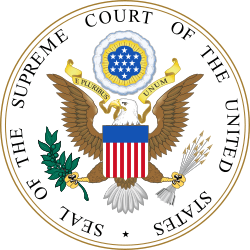United States v. Butler
United States v. Butler, 297 U.S. 1 (1936), was a U.S. Supreme Court case in which the Court held that the U.S. Congress's power to lay taxes is not limited only to the level necessary to carry out its other powers enumerated in Article I of the U.S. Constitution, but is a broad authority to tax and spend for the "general welfare" of the United States.[1] The decision itself concerned whether the processing taxes instituted under the 1933 Agricultural Adjustment Act were constitutional.[2]
| United States v. Butler | |
|---|---|
 | |
| Argued December 9–10, 1935 Decided January 6, 1936 | |
| Full case name | United States v. Butler, et al. |
| Citations | 297 U.S. 1 (more) 56 S. Ct. 312; 80 L. Ed. 477; 1936 U.S. LEXIS 946 |
| Case history | |
| Prior | Franklin Process Co. v. Hoosac Mills Corp., 8 F. Supp. 552 (D. Mass. 1934); reversed sub nom. Butler v. United States, 78 F.2d 1 (1st Cir. 1935); cert. granted, 296 U.S. 561 (1935). |
| Holding | |
| The Agricultural Adjustment Act is an unconstitutional exercise of power. | |
| Court membership | |
| |
| Case opinions | |
| Majority | Roberts, joined by Hughes, Van Devanter, McReynolds, Sutherland, Butler |
| Dissent | Stone, joined by Brandeis, Cardozo |
| Laws applied | |
| U.S. Const. amend. X, Agricultural Adjustment Act | |
A tax for an impermissible regulatory purpose
The main issue of the case was whether certain provisions of the Agricultural Adjustment Act of 1933 conflicted with the Constitution. In the Act, a tax was imposed on processors of farm products, the proceeds to be paid to farmers who would reduce their area and crops. The intent of the act was to increase the prices of certain farm products by decreasing the quantities produced.
The Court held that the so-called tax was not a true tax,[3] because the payments to farmers were coupled with unlawful and oppressively coercive contracts[3] and the proceeds were earmarked for the benefit of farmers complying with the prescribed conditions. The court also held that making the payment of a government subsidy to a farmer conditional on the reduction of his planned crops went beyond the powers of the national government.[3] Specifically, Justice Roberts said:
The act invades the reserved rights of the states. It is a statutory plan to regulate and control agricultural production, a matter beyond the powers delegated to the federal government. The tax, the appropriation of the funds raised, and the direction for their disbursement, are but parts of the plan. They are but means to an unconstitutional end.
Taxing and spending for the general welfare
Although it struck down the Act, the Court dealt positively with taxation and the expenditure of funds to advance the general welfare as specified in Article 1 § 8 of the Constitution. The Court stated that the issue “presents the great and the controlling question in the case.” After comparing expansive vs. restrictive interpretations of the Spending Clause, the Court adopted the philosophy that:
The clause confers a power separate and distinct from those later enumerated[,] is not restricted in meaning by the grant of them, and Congress consequently has a substantive power to tax and to appropriate, limited only by the requirement that it shall be exercised to provide for the general welfare of the United States. … It results that the power of Congress to authorize expenditure of public moneys for public purposes is not limited by the direct grants of legislative power found in the Constitution.
The fact that the Court struck down the Act despite an expansive interpretation of the Spending Clause reflects the turmoil in the Court at this critical time.[3] It was accepted that Chief Justice Hughes did not agree with the majority opinion's argument that the law's government subsidy regulations went beyond the powers of national government and was going to write a separate opinion upholding the act's subsidy provision while striking down the act's tax provision on the grounds that it was a coercive regulation rather than a tax measure until Roberts convinced Hughes he would side with him and the court's three liberal justices in future cases pertaining to the nation's agriculture which involved the Constitution's General Welfare Clause if he agreed to join his opinion.[3]
Indicating that turmoil and the fact that Butler was a turning point in the Court's thinking, in later jurisprudence Butler has been referenced to support expansion of authority under the Spending Clause (e.g., Steward Machine Company v. Davis, 301 U.S. 548 (1937), and Helvering v. Davis 301 U.S. 619 (1937)) and to dissent from such expansion e.g. South Dakota v. Dole, 483 U.S. 203 (1987), O’Connor dissent. In her dissent, Justice O’Connor noted that Butler was the last case in which the Supreme Court struck down an Act of Congress as an overextension of its spending power. This was part of a series of cases decided by the conservative Supreme Court of the time period which declared unconstitutional parts of Franklin D. Roosevelt's New Deal legislation.
See also
- Schechter Poultry Corp. v. United States (1935)
- List of United States Supreme Court cases, volume 297
References
Footnotes
- Chemerinsky (2015), p. 282.
- United States v. Butler, 297 U.S. 1 (1936).
- Henretta, James A. (Spring 2006). "Charles Evans Hughes and the Strange Death of Liberal America". Law and History Review. 24 (1): 115–171. doi:10.1017/S0738248000002285. ISSN 1939-9022.
Works cited
- Chemerinsky, Erwin (2015). Constitutional Law: Principles and Policies (5th ed.). New York: Wolters Kluwer. ISBN 978-1-4548-4947-6.CS1 maint: ref=harv (link)
External links

- Text of United States v. Butler, 297 U.S. 1 (1936) is available from: Cornell CourtListener Findlaw Google Scholar Justia Library of Congress Oyez (oral argument audio)